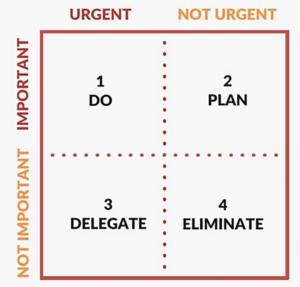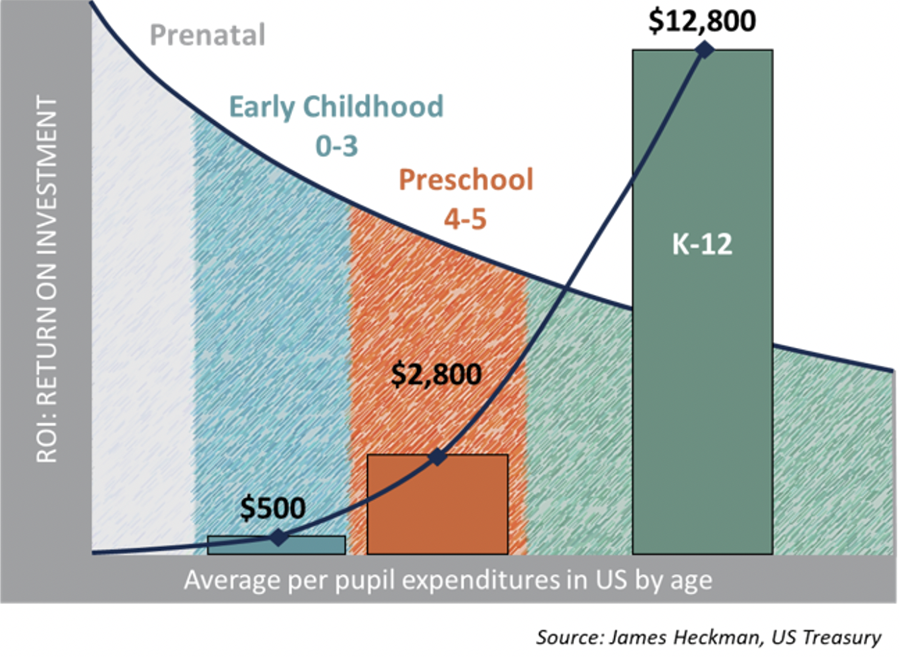Mark Mangrum | 08.15.2023
The Eisenhower Matrix for Child Care
“Children are not a distraction from more important work – they are the most important work,” according to C.S. Lewis. However, parents also have other important work, including earning a living and building careers. For many parents, that generally means spending a considerable amount of time outside of their homes and away from their children while entrusting them to other caregivers. Even remote work is not super productive when balancing an infant or toddler with Zoom meetings and creative tasks. For most working households, child care is essential. Some families are able to utilize friends and family as caregivers, while many rely on some form of a community-based child care program.

Unfortunately for many families today, finding child care whose hours and affordability meet their needs is all too challenging. In fact, 2021 data from the Chamber of Commerce Foundation found that 30% of Texans have left a job, not taken a job or greatly changed jobs due to challenges finding child care. So how can society best support parents when they need to work away from their children?
The Eisenhower Matrix is a task management tool that helps you organize and prioritize tasks by urgency and importance. If we use this matrix as a framework for decision-making, the “tyranny of the urgent” versus the “prioritization of the important” can be balanced.
Some examples of parent situations that determine which quadrant applies:
- Quadrant 1 (Important – Urgent). Parents with a paycheck job would likely place child care in the DO quadrant. Parents must do the job, and for most, deciding what to do about child care is an immediate obstacle to overcome. But finding the ideal child care provider can be time consuming and involve trial-and-error. So in spite of the importance, working parents may postpone a stable decision by acting too urgently, perhaps asking neighbors and family to babysit, or other temporary solutions. The National Library of Medicine says that child care instability usually results in child behavior problems, attachment issues and socio-emotional learning delays, plus parental stress.
- Quadrant 3 (Not Important – Urgent) Parents with a paycheck job may feel an urgent need for child care, but choose the DELEGATE quadrant because they do not value a community-based, high-quality, early education program as important. They may have a built–in support system, like a live-in relative, or some other form of traditional babysitting, or even outside daycare. These children will not benefit from the full range of early childhood education and care that most government and industry experts promote.
- Quadrant 4 (Not Important – Not Urgent) Some parents may prefer the ELIMINATE quadrant, if they work from home, or can afford to not work a paycheck job at all, or feel their children are mature enough to care for themselves. A fully engaged parent is the ideal scenario, but the more common scenario is parents delegating some child care to digital distractions. The digital dangers these days which children face can be far worse than the historical risks faced by “latchkey kids” left home alone.
- Quadrant 2 (Important – Not Urgent) The most powerful impact can come from parents choosing the PLAN quadrant. Investing in the work to match their child’s learning style and other needs to the right child care solution can have lifetime rewards. An early childhood education plan can be DIY researched, provided by a government-sponsored blueprint, or collaboratively discovered with subject matter experts. The impatient General Patton believed “a good plan executed urgently is better than a perfect plan executed next week” but child care planning is better done right than just urgently.
Society should support the superior choice to plan. This means ensuring that working parents have choices so that they can act out of best interest for their family and their child, rather than out of urgency or a scarcity mindset. Children are our greatest asset. Even though child care may be feel seemingly less urgent than jobs, the quality of child care is critical to the future of our society making it that much more important. Whether by a parent, family member or a high-quality caregiver, as the poet William Ross Wallace put it, “the hand that rocks the cradle rules the world.”
So, how do we ensure that all parents have options to choose from when selecting high-quality care for their young children? We must ensure there is an adequate supply of affordable, high-quality care. Today, the primary factor contributing to child care desserts and low supply of child care is the lack of early educators. Why? Poverty-level wages and inadequate opportunities for career advancement, combined with rigorous hours and working conditions have made the job less and less attractive.

Common sense would suggest that early childhood educators be well compensated. Simple logic would state that high quality has a high price tag. Yet study after study shows that low pay for early childhood educators is systemic, often 30% to 50% less than a K-12 teacher. Both ECE and K-12 teachers care for the same child at different ages for very different wages. If society justifies this inequity because the K-12 teacher is better educated, then we are rewarding the teacher’s education rather than funding the education of the child. In fact, research tells us that the majority of brain development happens in a child’s first five years of life—before they even reach kindergarten. Yet, the resources spent on children ages 0-5 is actually the inverse of their brain development.
It is an inconvenient truth that basic quality babysitters are often paid higher hourly wages than early childhood educators. This perversity persists due to multiple factors. For example, babysitters are paid for the convenience of urgent availability and one-on-one attention, while early childhood educators are expected to work for less hourly pay in exchange for full time care of a whole classroom. The consequence can be difficulty recruiting high-quality teachers, low retention of staff, poor engagement, higher turnover of students and reduced access to quality child care. As a society, we need to recognize that the need for high-quality care—regardless of the setting—is urgent! And, the early educators in our community-based child care programs are on the front lines, doing some of our society’s most important work.
Recognizing the role of early childhood education and K-12 education as equally vital is a first step in solving the ECE challenges. Entrepreneurs have opportunities and our government has responsibilities to collaborate on myriad solutions. Ongoing experiments and data-informed pilots are proving that foundational funding and contract incentives can produce sustainable business models that include hybrid private-government partnerships. For example, the Tarrant County Prime Pilot is developing a new funding formula that would enable public child care dollars to directly support increased compensation for early educators. This represents a needed mindset around public funding for child care: providing child care subsidies for families is important, but does little good if there are no early educators to run the classrooms.
The facts are that quality child care is a complex puzzle. Yet the truth is that some pieces are obvious, like better teacher pay supplemented by public funding. Ratcheting up regulations and mandating more red tape without adequate public funding is like using a carrot as a stick to beat the mule. Let’s reverse the slow-motion implosion of the child care industry.

